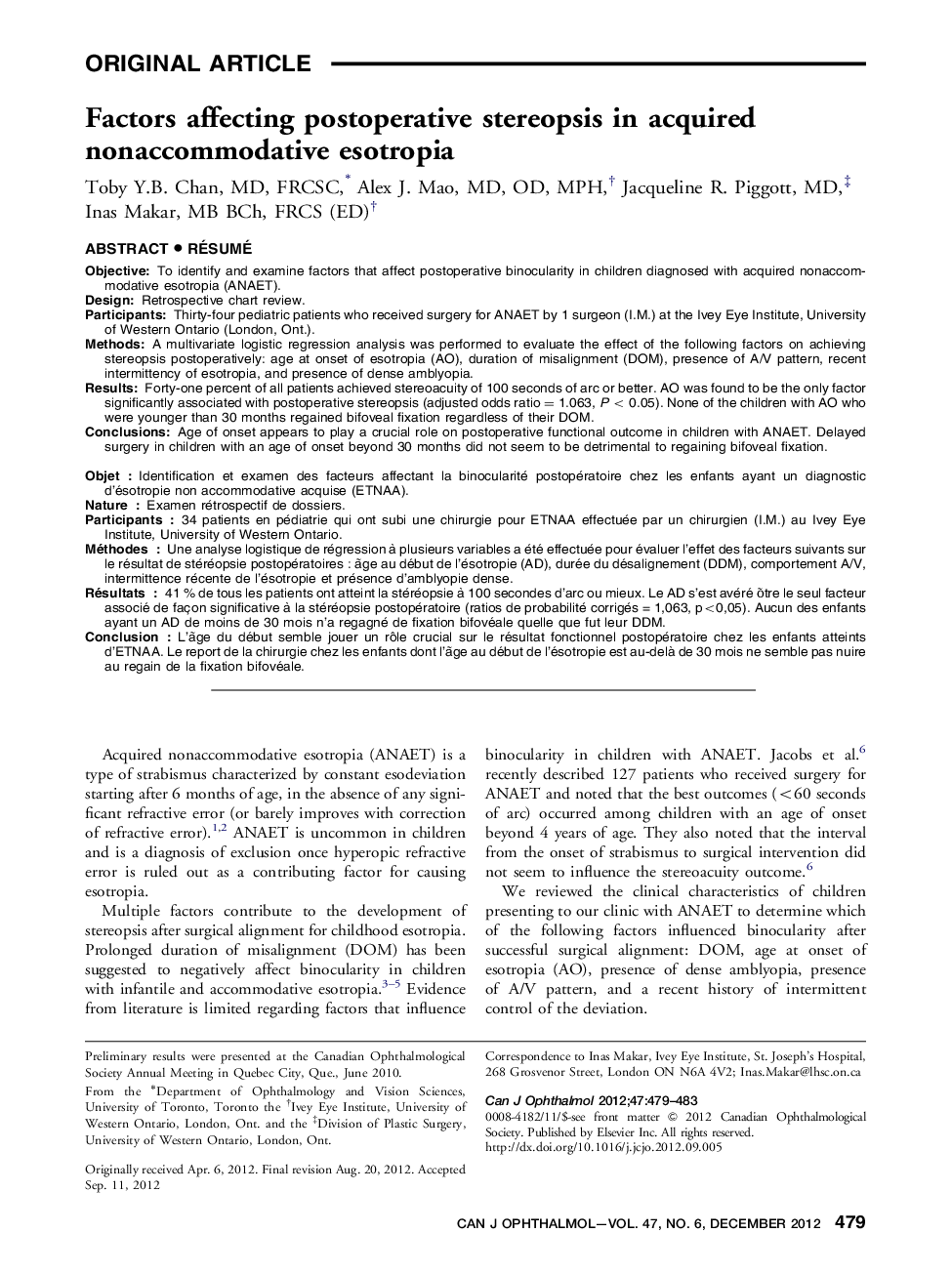| Article ID | Journal | Published Year | Pages | File Type |
|---|---|---|---|---|
| 4010084 | Canadian Journal of Ophthalmology / Journal Canadien d'Ophtalmologie | 2012 | 5 Pages |
ABSTRACTObjectiveTo identify and examine factors that affect postoperative binocularity in children diagnosed with acquired nonaccommodative esotropia (ANAET).DesignRetrospective chart review.ParticipantsThirty-four pediatric patients who received surgery for ANAET by 1 surgeon (I.M.) at the Ivey Eye Institute, University of Western Ontario (London, Ont.).MethodsA multivariate logistic regression analysis was performed to evaluate the effect of the following factors on achieving stereopsis postoperatively: age at onset of esotropia (AO), duration of misalignment (DOM), presence of A/V pattern, recent intermittency of esotropia, and presence of dense amblyopia.ResultsForty-one percent of all patients achieved stereoacuity of 100 seconds of arc or better. AO was found to be the only factor significantly associated with postoperative stereopsis (adjusted odds ratio = 1.063, P<0.05). None of the children with AO who were younger than 30 months regained bifoveal fixation regardless of their DOM.ConclusionsAge of onset appears to play a crucial role on postoperative functional outcome in children with ANAET. Delayed surgery in children with an age of onset beyond 30 months did not seem to be detrimental to regaining bifoveal fixation.
RésuméObjetIdentification et examen des facteurs affectant la binocularité postopératoire chez les enfants ayant un diagnostic d'ésotropie non accommodative acquise (ETNAA).NatureExamen rétrospectif de dossiers.Participants34 patients en pédiatrie qui ont subi une chirurgie pour ETNAA effectuée par un chirurgien (I.M.) au Ivey Eye Institute, University of Western Ontario.MéthodesUne analyse logistique de régression à plusieurs variables a été effectuée pour évaluer l'effet des facteurs suivants sur le résultat de stéréopsie postopératoires : ãge au début de l'ésotropie (AD), durée du désalignement (DDM), comportement A/V, intermittence récente de l'ésotropie et présence d'amblyopie dense.Résultats41 % de tous les patients ont atteint la stéréopsie à 100 secondes d'arc ou mieux. Le AD s'est avéré õtre le seul facteur associé de façon significative à la stéréopsie postopératoire (ratios de probabilité corrigés = 1,063, p<0,05). Aucun des enfants ayant un AD de moins de 30 mois n'a regagné de fixation bifovéale quelle que fut leur DDM.ConclusionL'ãge du début semble jouer un rôle crucial sur le résultat fonctionnel postopératoire chez les enfants atteints d'ETNAA. Le report de la chirurgie chez les enfants dont l'ãge au début de l'ésotropie est au-delà de 30 mois ne semble pas nuire au regain de la fixation bifovéale.
